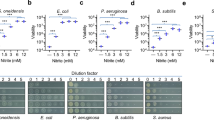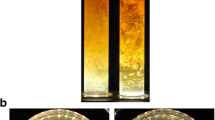Abstract
Nitrite was shown to inhibit active transport, oxygen uptake, and oxidative phosphorylation byPseudomonas aeruginosa. The evidence strongly suggested that nitrite exerted its inhibitory effect by oxidizing ferrous iron of an electron carrier(s), such as cytochrome oxidase, to ferric iron. The inhibitory effect of nitrite was readily reversible by washing the cells. Glucose transport byStreptococcus faecalis andS. lactis was not inhibited by nitrite, presumably because these species lack cytochromes and because glucose is transported by the phosphoenolpyruvate: phosphotransferase system rather than by active transport.
Similar content being viewed by others
Literature Cited
Ala-Finikku, K., Nurmi, P., Pajulshi, H., Raevuori, M. 1977. Effect of nitrite, storage temperature and time onClostributium botulinum type A toxin formation in liver sausage, European Journal of Applied Microbiology4: 145–149.
Banczafi, K., Paul, E. A., Wiehe, W. J. 1976. The extraction and measurement of adenosine triphosphate from marine sediments. Limnology and Oceanography21: 473–480.
Binkerd, E. F., Kolari, O. E. 1975. The history and use of nitrate and nitrite in the curing of meat. Food and Cosmetic Toxicology13: 655–661.
Buchanan, R. L., Solberg, M. 1972. Interaction of sodium nitrite, oxygen and pH on growth ofStaphylococcus aureus, Journal of Food Science37: 81–85.
Castellani, A. G., Niven, C. F., Jr. 1955. Factors affecting the bacteriostatic action of sodium nitrite. Applied Microbiology3: 154–159.
Chance, B. 1957. Techniques for the assay of respiratory enzymes, pp. 273–329. In: Colowick, S. P., Kaplan, N. O. (eds.), Methods in enzymology, vol. 4. New York, London: Academic Press.
Cheah, K. S. 1974. Effect of nitrite on respiration and oxidative phosphorylation. International Journal of Biochemistry5: 349–352.
Guymon, L. F., Eagon, R. G. 1974. Transport of glucose, gluconate, and methyl α-d-glucoside byPseudomonas aeruginosa. Journal of Bacteriology117: 1261–1269.
Harold, F. M., Baarda, J. R. 1968. Inhibition of membrane transport inStreptococcus faecalis by uncouplers of oxidative phosphorylation and its relationship to proton conduction. Journal of Bacteriology96: 2025–2034.
King, T. E. 1966. Glucose dehydrogenases-particulate. II.Acetobacter suboxydans, pp. 98–103. In: Wood, W. A. (ed.), Methods in enzymology, vol. 9, New York, London: Academic Press.
Mokrasch, L. C., McGilvery, R. W. 1956. Purification properties of fructose-1,6-diphosphatase. Journal of Biological Chemistry221: 909–919.
Phibbs, P. V., Jr., Eagon, R. G. 1970. Transport and phosphorylation of glucose, fructose and mannitol byPseudomonas aeruginosa. Archives of Biochemistry and Biophysics138: 470–482.
Rigand, J., Puppo, A. 1977. Effect of nitrite upon leghemoglobin and interaction with nitrogen fixation. Biochimica et Biophysica Acta497: 702–706.
Rowe, J. J., Hodge, T. W., II, Eagon, R. G. 1977. Nitrite inhibition of active transport and of respiration inPseudomonas aeruginosa. Abstracts of the Annual Meeting of the American Society for Microbiology1977: 223.
Strahler, B. L., Totter, J. R. 1952. Firefly luminescence in the study of energy transfer mechanisms. I. Substrate and enzyme determination. Archives of Biochemistry and Biophysics40: 28–41.
Thauer, R. K., Jungerman, K., Decker, K. 1977. Energy conservation in chemotrophic anaerobic bacteria. Bacteriological Reviews41: 100–180.
Williams, D. R., Rowe, J. J., Romero, P., Eagon, R. G. 1978. DenitrifyingPseudomonas aeruginosa: Some parameters of growth and active transport. Applied and Environmental Microbiology36: 257–263.
Yamanaka, T., Ota, A., Okunuki, K. 1960. Nitrite reductase activity ofPseudomonas cytochrome oxidase. Biochimica et Biophysica Acta44: 397–398.
Author information
Authors and Affiliations
Rights and permissions
About this article
Cite this article
Rowe, J.J., Yarbrough, J.M., Rake, J.B. et al. Nitrite inhibition of aerobic bacteria. Current Microbiology 2, 51–54 (1979). https://doi.org/10.1007/BF02601735
Issue Date:
DOI: https://doi.org/10.1007/BF02601735




